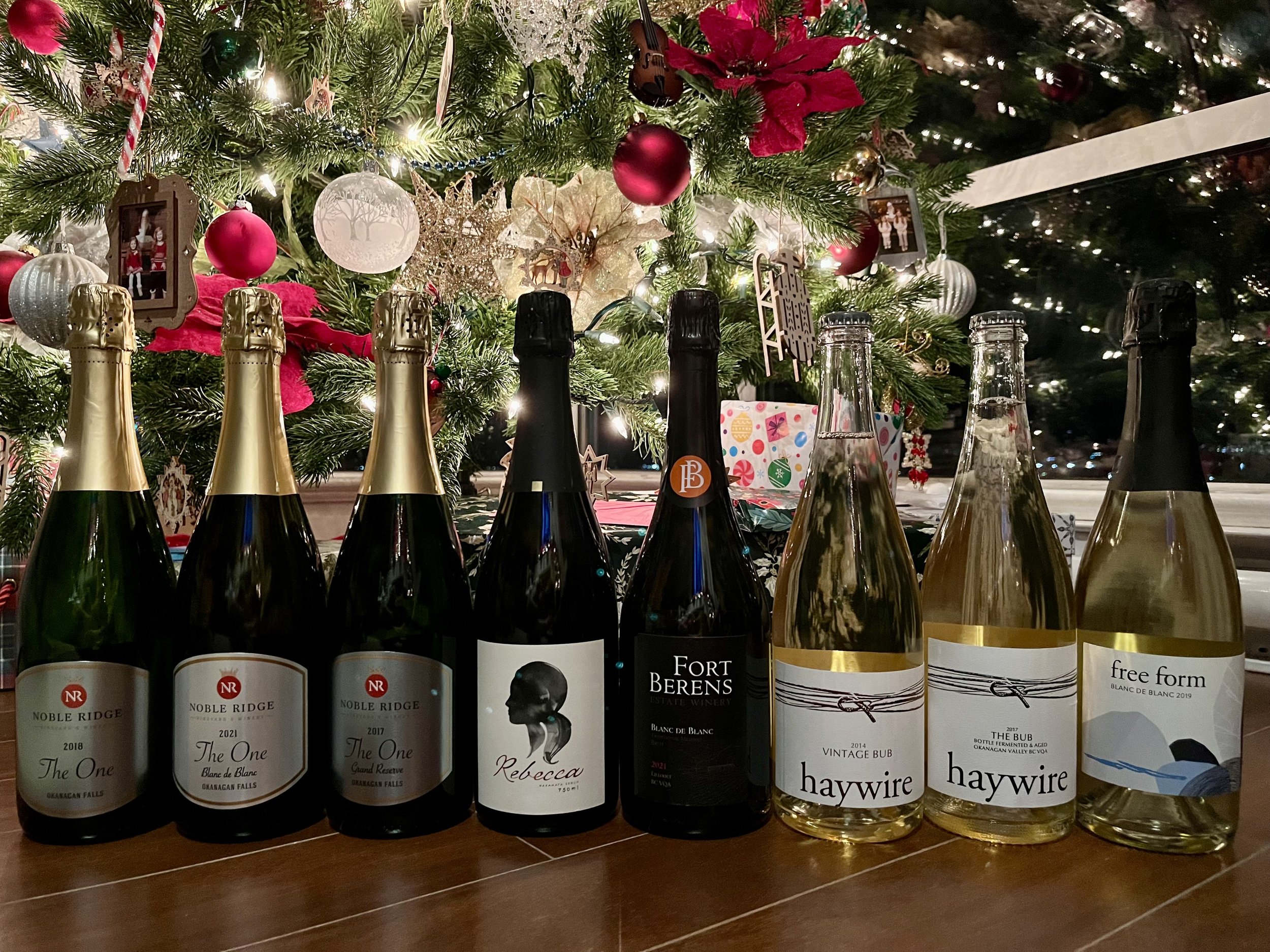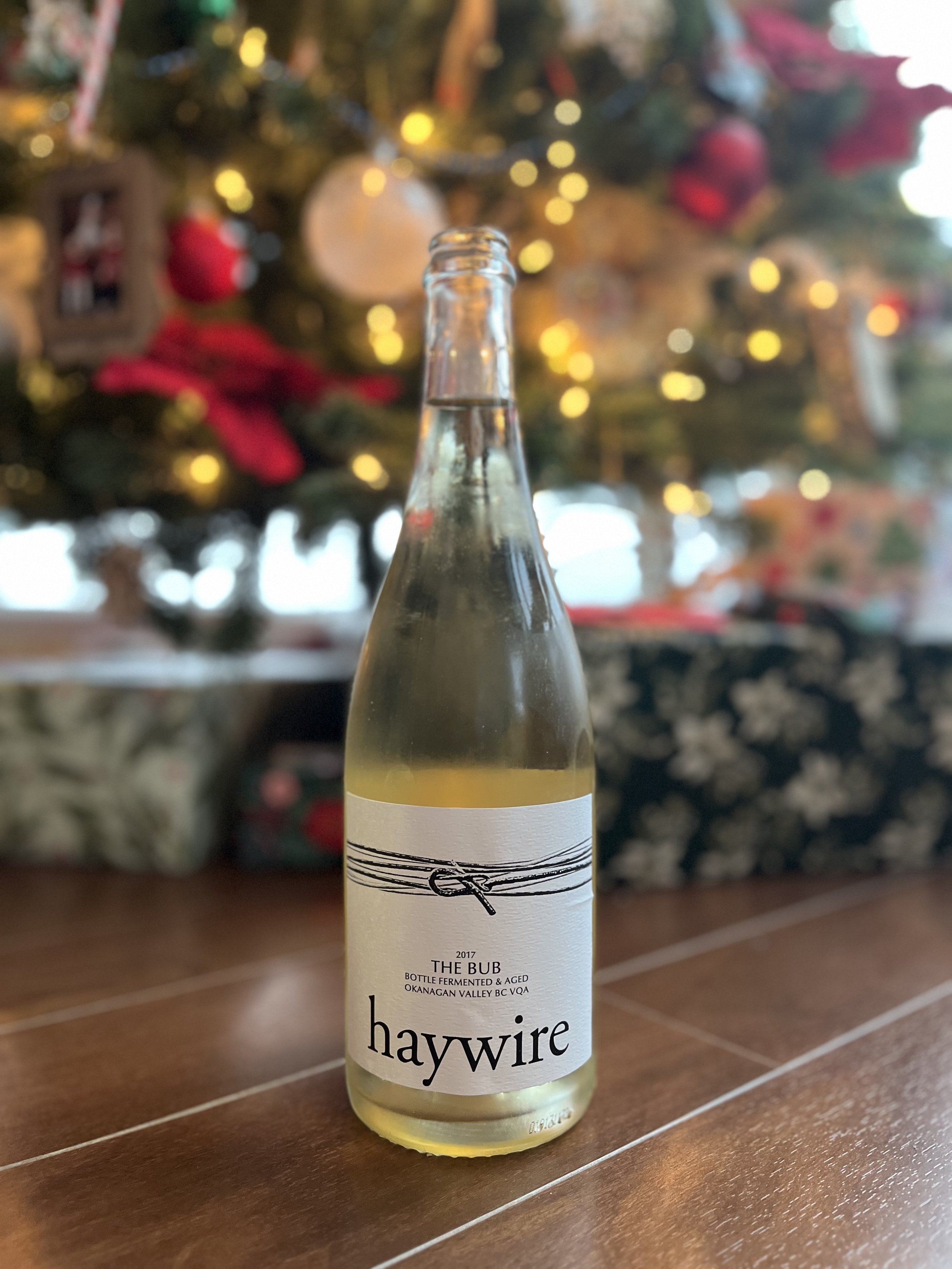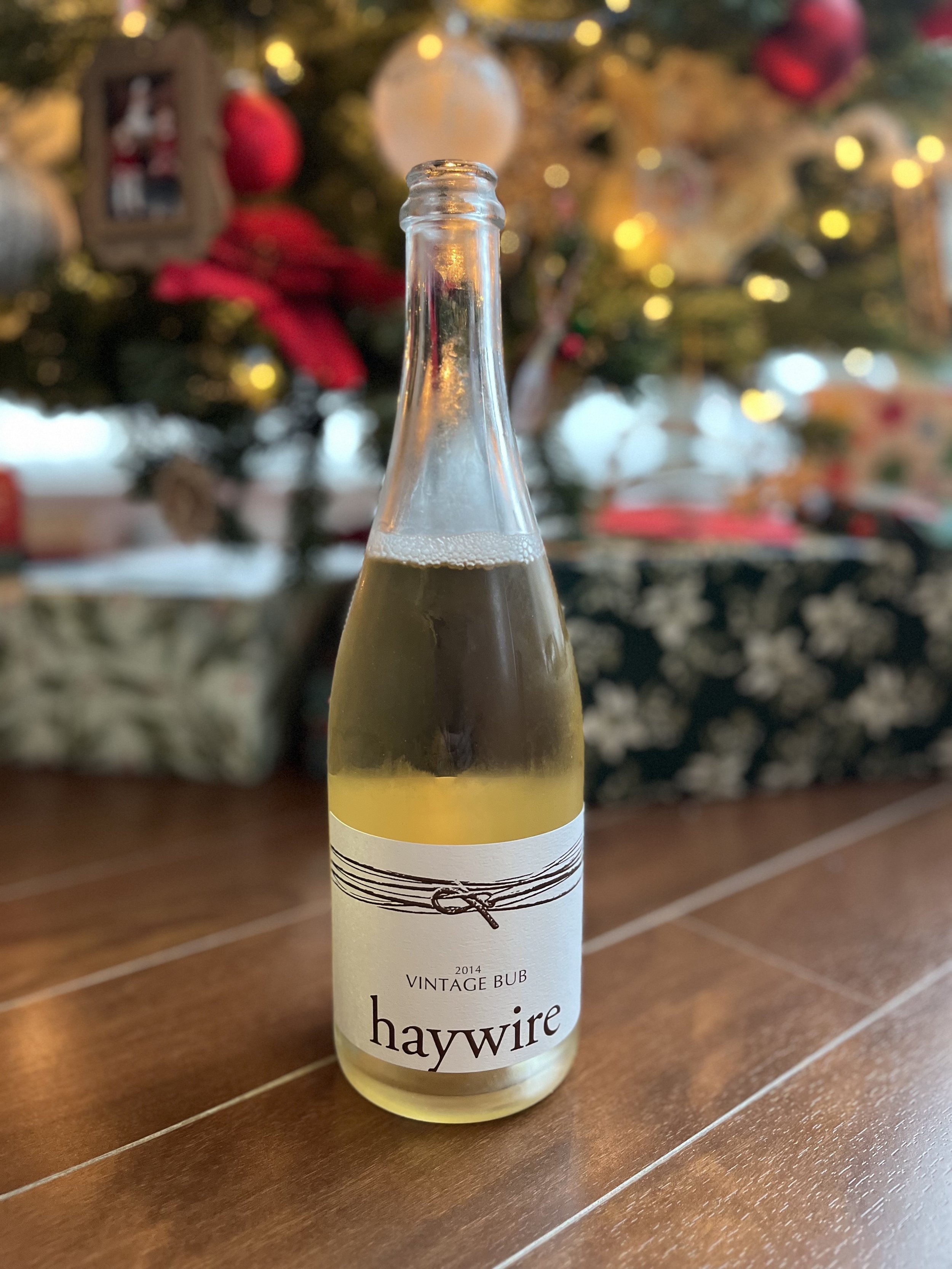A Primer On BC’s Exceptional Sparkling Wines
Of all the wonderful styles of wine that exist and grace our palates throughout the year, none is more synonymous with celebration and holidays than sparkling wines. They are ubiquitously associated with festivities, milestones, and luxury. In an upper tier class of their own, however, are those made by what’s known as the Traditional Method.
Also known as Méthode Traditionelle or Méthode Champenoise, this includes Champagne and regional Crémants of France, Cava from Spain, and South African Cap Classique. British Columbia has the geoclimatic gifts necessary to make exceptional traditional method sparkling wines, and we leverage these with resounding success. The key to quality production is achieving sufficient ripe flavours in the grapes, while keeping sugars minimal and acidity very high. More on this to come.
How are traditional method sparkling wines made? It’s a multi-step and demanding process, with many potential pitfalls.
Step 1 - A base wine is made from grapes harvested relatively early, at optimal ripeness and acidity. This wine will be neutral, dry, and very tart, with 10-11% abv.
Step 2 - The base wine is blended with wines from different parcels, vineyards, or even other vintage reserves. The final blend is bottled along with an elixir of wine, sugar, yeast, yeast nutrients, and a clarifying agent. This kicks off a secondary fermentation in the bottle.
Step 3 - As fermentation progresses, the final alcohol level will increase by 1-2% and the suspended yeast cells die and sink in the bottle, undergoing autolysis. Aging on the lees (en tirage) will continue for as long as the producer intends. This process imparts bready, yeasty, biscuity flavours and aromas. Longer aging allows the fruit flavour to develop further as well, giving tertiary characteristics of dried fruit, caramel, and nuttiness.
Step 4 - The expended yeast needs to be collected at the neck of the bottle, in a process called riddling. Bottles are held at a downward angle while rotated gradually. This can be done by hand or machine, the former being more labour intensive and therefore more expensive.
Step 5 - The yeast collected in the neck is frozen into a plug and ejected from the bottle during disgorgement. The volume is topped up with additional wine, and it’s here the producer has the option to add some sugar to achieve the desired balance. This is referred to as the dosage.
The wines are now ready for sale, however some producers may choose to cellar for additional months or even years before release. This will increase flavour complexity, and also the price.
Did you know? Sparkling wines are bottled in thicker, heavier glass which can withstand the high pressures inside! The ‘punt’ at the bottom provides structural integrity - and also a handy spot for an experienced hand to hold while pouring!
Because of the nature of this extensive production method, very ripe and sweet grapes with concentrated flavours would not be appropriate. That precludes most warm regions from producing quality sparkling wines in this way. Cooler regions excel, where grapes can be harvested with still elevated acidity and mature yet delicate fruit flavour that doesn’t taste green or under ripe. This is why BC sparkling wines are so good! Areas like Lake Country, Summerland, Peachland, Okanagan Falls, and Vancouver Island produce spectacular sparklers due to their geography and climate.
Since wines undergo a secondary fermentation, lees aging, and potentially further bottle aging, it’s important to use grapes that do not provide lots of intense and complex aromatics. That’s why the royal three perpetually reign in this domain: Chardonnay, Pinot Noir, and Pinot Meunier. Wines made with 100% Chardonnay are called Blanc de Blanc, and if only the latter two are used, then you have a Blanc de Noir. Pink versions can be made either with some skin contact of the black grapes during the first fermentation, or by blending white and red base wines before the bottle fermentation.
So now that we understand what goes into a traditional method sparkling, we can understand what differences you will notice in the wines. The types of grapes used will affect the body and flavour base. The length of aging on lees will determine how much autolytic character you get, and additional cellaring time after disgorgement will also allow for more complex flavour development. Lastly, the level of dosage will affect the final balance, body, and mouthfeel. More and more producers are opting for zero dosage today, as they focus on precise fruit flavours and balance at the time of harvest, and consumer preference trends towards dryer styles.
Speaking of dry, you may see some different terms on the bottle which refer to the level of sweetness. There are no labeling regulations for this in Canada. But generally, if you want a dry wine, look for ‘Brut,’ ‘Brut Nature,’ or ‘Zero Dosage.’ If you're looking for a little bit of sweetness, terms like ‘Sec,’ ‘Demi-Sec,’ and even (confusingly) ‘Extra Dry’ indicate higher sugar levels - but it’s best to ask an associate if you’re not sure.
Below are my reviews for 8 fabulous Traditional Method Sparkling Wines from BC producers, who kindly provided the wines for this article on request.
Free Form Blanc de Blanc 2019 - $49.99
100% Chardonnay from a single organic vineyard (Garnet Valley Ranch in Summerland) was used, grown in complex soil with volcanic and limestone content. En tirage extends for 42 months, following up with zero dosage. A striking, sharp, stemmy, pithy and precise Blanc de Blanc with a fine, frothy mousse and pronounced aromas and flavours of crisp apple and zingy citrus. Subtle toasty notes add a little complexity but it’s the chalky, mineral character that drives this titanium sparkling wine - strong yet light.
Haywire ‘The Bub’ 2017 - $29.99
55% Pinot Noir and 45% Chardonnay from Oliver and Summerland vineyards. En tirage was 30 months, with zero dosage, plus bottle aging after disgorgement. A pale gold shimmer and heavy froth emerge as you pour. This wine is a comforting apple turnover - a medium-bodied sparkler with green and yellow apple, toast, and biscuity goodness. Great balance and even better value.
Haywire ‘Vintage Bub’ 2014 - $49.99
A cuvée of 50/50 Chardonnay and Pinot Noir from vines at 487m up Secrest Mountain in North Oliver. The wine was aged en tirage for 52 months, with no dosage before corking. This has classic aged champagne aromas of apple, lemon curd, dried peel, brioche, and almond. The palate has the fresh fruit, dried fruit, and shortbread cookies. Whereas the 2017 Bub has more lively personality, this wine is more about dried fruit and lees character. A complete and mature sparkling wine.
Three Sisters ‘Rebecca’ 2019 - $45.00
Named after winery owner Rebecca Mikulic (partner to winemaker Matthew Mikulic). Composed of 90% Chardonnay and 10% Pinot Noir, this bottling received Platinum from the Lieutenant Governor’s Wine Awards in 2022. En tirage was 15-16 months with 9 months bottle aging after disgorgement in 2021. Steady, medium sized bubbles rise through a soft golden lens. There is remarkable complexity given the relatively short aging program. The nose is beautiful and expressive of citrus peel, candied fruit, apples, yeast, and blanched almonds. The palate presents with apple cake, lemon zest, and custard buns. An outstanding BC sparkler as good as any aged Champagne.
Noble Ridge ‘The One’ 2018 - $34.99
Awarded silver at the 2024 Decanter World Wine Awards. Winemaker Benoit Gauthier makes sparkling wines from single vintages only and all from estate Okanagan Falls vineyards, the better to showcase the fruit as a reflection of its environment. Chardonnay (72%) and Pinot Noir (28%) are whole cluster pressed, with 47 months en tirage. Pale gold and frothy with steady streams of small bubbles. Aromas are mostly in the citrus and apple domain with some walnut, brioche, and wet rock accents. The wine is bright and lively through the long finish with a bit more body than a Blanc de Blanc. An insightful demonstration of blending skill and terroir transparency.
Noble Ridge ‘The One’ Blanc de Blanc 2021 - $34.99
The One, made with 100% estate Chardonnay. Without the accompanying Pinot Noir this wine is all about edgy, acute lemon and apple essence with bready and mineral notes in the background. The sharply acidic palate (not unlike all the rest) is honed and ready for an oyster pairing. Flavours are bright and punchy yet not too intense - fresh citrus, tart crunchy apple and Yorkshire pudding.
Noble Ridge ‘The One’ Grand Reserve 2017 - $49.99
This piéce de résistance is made from 78% Chardonnay and 22% Pinot Noir, and otherwise in the same manner as The One, with longer lees aging: a stunning 66 months in bottle. In the time this wine spent developing before disgorgement, a newborn infant would learn to crawl, walk, run, talk, read, and write. This wine too is ready for the world with a solid foundation of attributes, and indelible personality. If you love aged champagne but without having to do the aging yourself - this is the whole package. Ripe apple, citrus peel, dried apricot, sultanas, almonds, and arrowroot biscuit all interplay in a complex sensory pâtisserie.
Fort Berens Blanc de Blanc 2021 - $34.99 (SOLD OUT - stay tuned for the 2022 vintage)
100% Lillooet estate Chardonnay from Dry Creek Vineyard whole bunch pressed, with 20 months en tirage. Disgorged in March 2024. A smooth, creamy mousse envelops the delicate and straightforward qualities of citrus, apple, and fresh dough. It is light, clean, and crisp, and perfect for celebrating. This is a highly approachable, very well made entry level champagne. Young and fresh.
Sales of sparkling wines remain much higher than even just 10 years ago, indicating the public’s increasing comfort with this style of wine as standard table fare. We might spend a bit more on a fancier bottle around the holidays, but more and more we are reaching for these wines for everyday enjoyment. That’s a good thing, and it tells producers that what they’re doing is really working.
When you raise a glass to make a toast this season, you can’t go wrong with a BC sparkling wine made with the care and dedication required of the traditional method. They are prized for their refreshing, zippy acidity, complexity and elegance of flavour, while remaining approachable and fun.
Whatever you decide to drink, enjoy the experience the wine brings you, and share it with others. Happy Holidays everyone, and have a wonderful New Year!
This Blog Post was written by our contributor: Matt Tinney with MT Wine Consulting (@mtwineconsulting).











